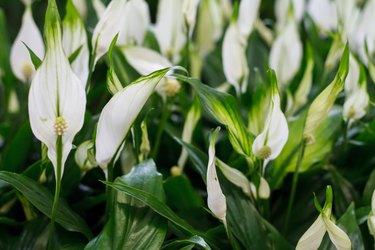
When the white flowers of a peace lily (Spathiphyllum spp.) -- a plant beloved for its willingness to bloom even indoors in poor light -- start turning brown, a natural reaction is to blame: a disease or the wrong growing conditions are turning your Spathiphyllum flowers brown. The reality is that, while both these problems cause discoloration, they usually affect a peace lily's leaves, not its blooms.
A Natural Progression
Video of the Day
What you likely recognize as a peace lily flower is technically a spathe, or modified leaf. It emerges white and develops a pale green tinge over the next 10 days. The actual flowers cover the spadix, the fleshy spike protruding from the spathe.
Video of the Day
Flower browning is most often a sign of the bloom's age. The yellowish spadix flowers become dry and brown before releasing their pollen. If a powdery white substance sprinkles the plant and the surrounding surfaces, the pollen has been released. The spathe will soon turn brown and die.
Tip
When Spathiphyllum flowers brown from age, snip them off at the base of their stems to keep the plant looking its best. Use clean, sharp scissors wiped beforehand in rubbing alcohol. Removing the spathe encourages the plant to grow a replacement.
Other Possibilities
Thrips
Most insects ignore peace lilies. Western flower thrips are nasty little beasts that puncture a peace lily's spathes to drain the cellular contents. Infested spathes may turn brown. Peace lily thrips most often affect large-flowered cultivars.
If you notice small, slender dark insects or wet, shiny spots on the spathes, isolate the plant immediately for treatment.
Things You'll Need
Organic, ready-to-use insecticidal soap spray
Protective clothing, including a long-sleeved shirt, long pants and safety goggles.
Prepare the Treatment Area
Move the peace lily out of direct sun and cover the surrounding surfaces to protect them from dripping soap. If the weather is above 60 degrees Fahrenheit, take it outdoors to spray it, if possible.
Protect Your Person
Put on the protective clothing and safety goggles.
Spray Peace Lily Thrips Mercilessly
Spray the plant to the point of runoff, until the soap drips from all its surfaces, being sure to hit both sides of all the spathes and leaves.
Don't Let Up
Repeat weekly, or as often as the soap's label suggests, until the thrips are gone.
Watering and Humidity
Although an underwatered peace lily may produce brown spathes, the plant obligingly announces when it's time to water by drooping slightly. As a general rule, watering the peace lily once each week to soak the entire root ball and letting the plant drain thoroughly prevents excessively dry or wet soil.
Like all tropical plants, the peace lily is a lover of humidity. A deprived plant will punish lack of humidity with peace lily drooping and browning spathes, leaf tips and edges. Combat this condition easily by placing the plant near a humidifier, though not in its direct path. Other options include frequent misting, or setting the peace lily on a pan of wet pebbles.
Tip
Although peace lilies commonly grow as outdoor perennials in U.S. Department of Agriculture plant hardiness zones 11 through 12, they're most often sold as easy-care tropical houseplants.